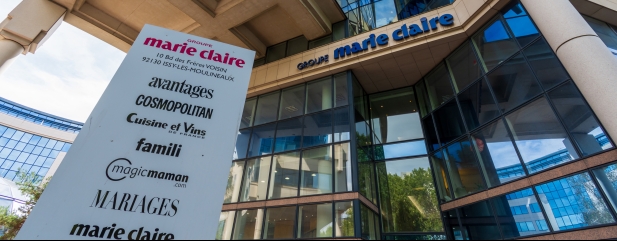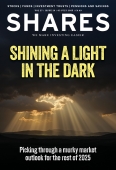Archived article
Please note that tax, investment, pension and ISA rules can change and the information and any views contained in this article may now be inaccurate.
Can one-time market star Future shine again?

Specialist media group Future (FUTR) served up its latest disappointment in May, reporting a poor set of first-half results which it blamed on macroeconomic uncertainty.
The full-year outlook was also revised downward and the company now expects a low-single-digit decline in full-year 2025 organic revenue.
Year-to-date Future shares have fallen more than 20% to 749p which translates to a market valuation of £785 million. This is a far cry from its share price peak of nearly £40 and market cap of around £4.5 billion achieved in 2021, with the stock something of a market darling at that time.
So, what has gone wrong for the company, which owns a slew of well-known UK brands like price comparison website Go Compare and iconic magazine titles Marie Claire and TechRadar? And can its first-quarter update on 17 July arrest the decline by showing signs of improvement or at least stabilisation in its end markets?
WHAT DOES FUTURE DO?
Founded in 1985 by Chris Anderson, the FTSE 250 company is made up of two divisions – media and magazines.
The company’s media division generates revenue from digital advertising, affiliate revenue for products, rewards, price comparison and events. The magazine division includes revenue associated with digital or printed magazines or bookazines, from advertising to subscriptions to newstrade.
Under previous chief executive Zillah Byng-Thorne, who ran Future from 2014 to 2023, the business expanded rapidly, largely through M&A.
Just running through some of the highlights, the acquisition of TI Media in April 2020 for £140 million enabled the group to move into the home and women’s lifestyle segments with titles including Country Life and Women and Home.
In February 2021, Future branched out into the price comparison website field with the £594 million takeover of GoCo, the parent company of price comparison website Go Compare. It also acquired 12 magazine titles from Dennis Publishing in August 2021 for £300 million.
The approach was to focus on brands, covering topics from films to computer games and photography, which were and are a conduit between fans and their enthusiasm or hobby – often picking up these titles cheaply thanks to the structural pressures on traditional publishing. This helped drive a loyal and engaged audience which Future could monetise, employing a centralised platform to derive e-commerce, licensing and digital advertising revenue. The aim was to get readers to click through to partnered retailers and events.
WHAT HAS GONE WRONG?
The company has been badly impacted by a weaker outlook for global advertising spend as well as changes in the online media landscape, and it was clear new head Jon Steinberg had a challenging task ahead of him when he succeeded Byng-Thorne in April 2023.
Steinberg’s tenure was short-lived, leaving the company in October 2024 for family reasons. Despite making progress with Future’s growth acceleration strategy, his reign was clouded by the continued difficult backdrop.
Future’s websites are reliant on search engines as users navigate to them via the likes of Google.
Berenberg analysts observe: ‘With Google having made the decision to maintain third-party cookies in Chrome, the key overhang is the potential disruption to Future’s audience numbers as adoption of generative AI-grows (ChatGPT and Perplexity). To date, it appears there has been little disruption, with its audience down just 2% on an underlying basis in the first half of 2025.’
The question for new chief executive Kevin Li Ying is will the specialist media group be able to adapt its business model fast enough to compete in this fast-changing market landscape? Investors remain sceptical, according to Berenberg analysts, hence the share price is still stuck in the mire.
Future has also been affected by weak consumer sentiment, meaning people are less likely to buy goods and services from its commercial partners, and prospective advertisers are maintaining a tight rein on budgets. One of the key drivers for the sell-off which followed the first-half results was a big drop-off in US online advertising in March.
FUTURE’S VALUATION
The FTSE 250 company has an extremely depressed valuation. Panmure Liberum estimates stripping out price comparison website Go Compare, Future’s publishing business is currently trading on a EV/EBIT (enterprise value to earnings before interest and tax) ratio of just two times based on 2025 estimates, falling to 0.6 times for 2026.
In fact, the broker estimates the publishing arm is essentially on offer for free if GoCompare is valued using the average long-term valuation enjoyed by price comparison peer MONY Group (MONY), which owns Moneysupermarket.
The analysts suggest the true worth of Future’s media and magazine assets might be realised if GoCo is wholly or partially spun off. While a sale or spin-off could provide valuation transparency, it would require the separation and rebuilding of the support functions which have already been integrated into the group.
Also as with any sale or spin-off, it would take time to complete and would almost certainly reduce the profitability of the group in the short term.
Important information:
These articles are provided by Shares magazine which is published by AJ Bell Media, a part of AJ Bell. Shares is not written by AJ Bell.
Shares is provided for your general information and use and is not a personal recommendation to invest. It is not intended to be relied upon by you in making or not making any investment decisions. The investments referred to in these articles will not be suitable for all investors. If in doubt please seek appropriate independent financial advice.
Investors acting on the information in these articles do so at their own risk and AJ Bell Media and its staff do not accept liability for losses suffered by investors as a result of their investment decisions.
 magazine
magazine








